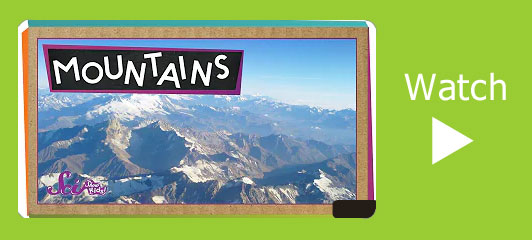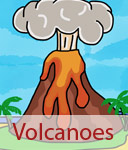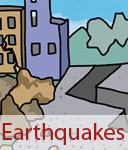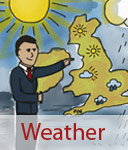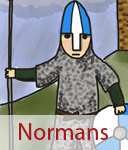

Facts about mountains
Facts about mountains for kids learning in Primary School. KS1 & KS2 learning. Homework help on Mountains and Peaks for kids.
What is a mountain?
A mountain is a very tall piece of land that rises high above the area around it. Mountains are usually much bigger and steeper than hills. To be called a mountain, most people say the land has to be at least 600 metres (about 2,000 feet) high.
At the very top of a mountain is the summit or peak, and the sides of a mountain are called the slopes. Some mountains are covered in grass and trees, while the highest ones can be bare rock or even covered in snow and ice all year round!
Mountains don’t just stand alone – they often come in groups called mountain ranges. Famous examples are the Himalayas in Asia or the Rocky Mountains in North America.
Mountains are important because they affect the weather, provide fresh water from rivers and glaciers, and are home to many plants, animals, and people.
What’s the difference between mountains, hills, and valleys?
It’s easy to get confused between mountains, hills, and valleys, but here’s how they’re different:
- Mountains – These are the tallest and steepest landforms. They rise very high above the land around them, often with rocky peaks or snow on top. (Example: Ben Nevis in Scotland.)
- Hills – These are smaller and rounder than mountains. Hills are usually covered in grass or trees and are easier to climb. (Example: The Cotswolds in England.)
- Valleys – A valley is the low area of land between mountains or hills. Rivers often flow through valleys, making them good places for farming and villages. (Example: The Vale of York in England.)
A simple way to remember:
- Mountains = high
- Hills = medium
- Valleys = low
How are mountains formed?
Did you know that about 5% of the Earth’s surface is covered by mountains? That means mountains are found all over the world, and they’ve been forming for millions of years.
Mountains are made because of the movement of the Earth’s crust. The Earth’s crust isn’t one solid piece – it’s broken into huge sections called tectonic plates, which are like giant puzzle pieces floating on melted rock deep below. These plates are always moving, but very slowly.
When two tectonic plates push together, the land between them is forced upwards, creating mountains. Imagine pushing two pieces of paper across a table until they crumple up – the “crumples” are like the peaks of mountains.
There are actually different types of mountains, depending on how the plates move:
- Fold Mountains – Made when plates collide and the rocks fold and crumple upwards. (Example: the Himalayas in Asia.)
- Block Mountains – Made when cracks in the Earth’s crust push big blocks of land up. (Example: the Sierra Nevada in the USA.)
- Volcanic Mountains – Made when magma (molten rock) erupts through the crust and piles up to form a mountain. (Example: Mount Fuji in Japan.)
Famous mountains around the world
There are thousands of mountains on Earth, but some are extra famous because of their size, beauty, or history. Here are a few of the most well-known mountains:
Mount Everest (Asia)
Mount Everest is the tallest mountain in the world, standing at 8,849 metres (29,032 feet). It’s part of the Himalayas, on the border between Nepal and China (Tibet). Climbers from all over the world try to reach its summit, but it’s very dangerous because of freezing temperatures and thin air. Snow leopards and Himalayan tahr (a kind of wild goat) live on the lower slopes.
Mount Kilimanjaro (Africa)
Found in Tanzania, Kilimanjaro is the highest mountain in Africa at 5,895 metres (19,341 feet). Unlike Everest, Kilimanjaro is a volcano (though it’s not erupting now). What makes it special is that you can walk from hot, grassy plains at the bottom all the way up to snowy glaciers at the top! Elephants, monkeys, and even leopards live around its base.
The Alps (Europe)
The Alps stretch across several countries, including France, Switzerland, Italy, Austria, and Germany. The tallest peak is Mont Blanc at 4,808 metres (15,774 feet). The Alps are famous for skiing, beautiful villages, and wildlife like ibex (wild goats), marmots (fluffy rodents), and golden eagles.
The Rocky Mountains (North America)
The Rockies, or “Rocky Mountains,” run through Canada and the USA for over 3,000 miles (4,800 km)! The tallest mountain in the Rockies is Mount Elbert in Colorado at 4,401 metres (14,440 feet). The Rockies are home to bears, moose, elk, and bald eagles. People love to visit for hiking, camping, and skiing.
Mountains in the UK
The United Kingdom may not have the tallest mountains in the world, but it still has some amazing peaks and ranges to explore!
The Three Peaks
The highest mountains in each country of Great Britain are known as the Three Peaks:
- Ben Nevis in Scotland – the tallest in the UK at 1,345 metres (4,413 feet).
- Snowdon (Yr Wyddfa) in Wales – the highest in Wales at 1,085 metres (3,560 feet).
- Scafell Pike in England – the highest mountain in England at 978 metres (3,209 feet).
Lots of walkers try the “Three Peaks Challenge,” where they climb all three in just 24 hours!
The Scottish Highlands
Scotland has the most mountains in the UK, especially in the Highlands in the north. This area is famous for its dramatic landscapes of mountains, valleys (called glens), and deep lakes (called lochs). Red deer, golden eagles, and mountain hares live here.
How were they formed?
Long ago, hundreds of millions of years in the past, the UK was part of massive mountain-building events when continents and tectonic plates collided. Over time, the rocks were pushed up to form huge mountain ranges. The Caledonian Orogeny (about 400 million years ago) created much of Scotland’s mountains. Later, during the last Ice Age, glaciers carved out the peaks and valleys we see today. That’s why many mountains in the UK look jagged, with sharp ridges and U-shaped valleys.
Mountain environments
Mountains are very special places because the environment changes as you go higher up. If you stand at the bottom of a mountain and then climb to the top, you will notice that the plants, animals, and even the weather are very different.
Temperature and air
The higher you go, the colder it gets. For every 100 metres you climb, the temperature can drop by about 1°C. This is because the air gets thinner (there is less oxygen), so it cannot hold as much heat. That’s why you often see snow at the top of tall mountains, even in summer!
High mountain peaks
At the very top, it can be icy, windy, and very hard for living things to survive. Few animals or people live here because the conditions are so extreme. Only the toughest creatures like snow leopards, yaks, and certain birds (like eagles) can survive. People who live in high mountain areas, like the Himalayas or Andes, often have bigger lungs or more red blood cells to help them breathe better in the thin air.
Mountain slopes and meadows
A bit lower down, where it’s not quite as cold, you’ll find rocky slopes and grassy areas. This is where mountain goats, sheep, and marmots can live. People sometimes build farms here and keep animals, but life is hard because villages are often cut off from the rest of the world. In these areas, traditional cultures have survived for hundreds of years because people don’t mix much with others.
The tree line and forests
Go even lower and you’ll reach the tree line. This is the point on the mountain where trees can grow because the air is warmer and less harsh. Below the tree line, you can find mountain forests filled with animals like bears, wolves, deer, and many birds. These forests provide food, wood, and shelter for both wildlife and people.
Mountain rivers and valleys
At the very bottom of many mountains, you’ll find rivers that start from melting snow and ice at the top. These rivers flow down into valleys, creating fertile land where more people can live, farm, and build towns.
The dangers of mountains
Mountains are exciting and beautiful places, but they can also be dangerous. Because the land is steep and the weather can change quickly, people and animals living or exploring mountains need to be very careful. Even though mountains can be dangerous, with the right preparation and safety measures, people can enjoy them safely. That’s why mountain rescue teams exist – they are trained to help people in trouble.
Avalanches
An avalanche happens when a huge amount of snow suddenly slides down the mountain at high speed. This can bury everything in its path, including people, animals, and trees. Skiers and climbers are most at risk.
How to stay safe: Experts check the snow conditions and warn people if there is a danger. Skiers often carry special rescue equipment like avalanche beacons and shovels.
Rockfalls and landslides
Loose rocks and soil can suddenly tumble down steep slopes, especially after heavy rain, melting snow, or earthquakes. These can block roads, destroy homes, or injure people.
How to stay safe: Signs and barriers are often put up in dangerous areas. Engineers sometimes place nets or walls along roads to catch falling rocks.
Extreme weather
On mountains, the weather can change very suddenly. One moment it may be sunny, and the next there may be thunderstorms, blizzards, or freezing winds. Because the air is thinner higher up, the cold feels even stronger.
How to stay safe: Climbers and hikers carry warm clothes, food, and emergency equipment. Checking the weather forecast before going up a mountain is very important.
Thin air
At very high altitudes, the air has less oxygen, making it hard to breathe. This can make people feel sick, dizzy, or very tired – something called altitude sickness.
How to stay safe: Climbers go up slowly to let their bodies get used to the thin air, and sometimes they use oxygen tanks on very high mountains.

